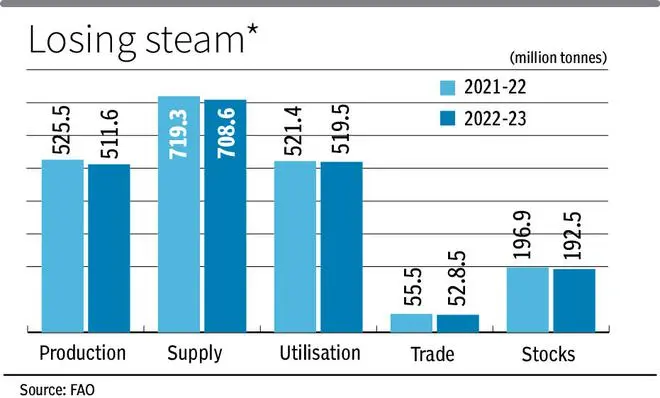Rice prices have soared to their highest since November 2011 with the production of the cereal projected to drop by 2.7 per cent during the current season (August 2022-July 2023), the Food and Agriculture Organisation (FAO) has said.
“Rice production is downgraded somewhat, largely on account of an area-based reduction for China, which overshadowed revisions for other countries, most notably an upgrade for Bangladesh,” the FAO’s Agricultural Market Information System said in its latest report.
Aromatic ones strengthen
Separately, the UN organisation’s Rice Price Update said international prices of rice opened on a firm note in January. FAO’s all rice price index averaged 126.4 points in January, up 6.2 per cent over December.
Prices of aromatic rice also strengthened by 9.8 per cent, sustained by demand for the (Chinese) Lunar New Year celebrations, preparative purchases for Ramadaan and post-harvest surge in Pakistan basmati quotations, the update said.
According to AMIS, rice production this season is projected at 511.6 million tonnes (mt) against 525.5 mt last season. Utilisation or demand is anticipated to remain close to the 2021-22 peak at 519.5 mt (521.4 mt last season), while supply has been projected at 708.6 mt (719.3 mt).
The demand is expected to remain near peaks as food intake expansion will compensate for a cut in other uses of rice. Trade is seen lower at 52.8 mt (55.5 mt) as countries in Asia and Africa are likely to prune imports.
Thai gains pronounced
Ending stocks are likely to be 2.3 per cent lower than last season at 192.5 mt, though they will be the third-highest on record.
The Rice Update said Asian quotations firmed up across all major origins in January. The most pronounced gains were in Thailand, where the Baht rose to a 10-month high. Sentiments were further boosted by Indonesian purchases.
Short-supplies due to a flood-reduced crop and “persistently inflationary pressure” compounded local demand for rice in Pakistan. Problems in wheat supply also drove up rice prices in the neighbouring country.
Prices increased in India, Vietnam and Brazil as the dollar strengthened. In Vietnam, availability was tight ahead of the winter-spring harvest, while in India record procurement by the government and a smaller kharif crop pushed up prices.
Prices down a tad now
Meanwhile, as per data from Thai Rice Exporters Association, prices have softened a tad, though India’s parboiled rice prices have gained $5 a tonne over the past 10 days.
Thailand’s 5 per cent broken rice declined to $511 a tonne from $523, while its 25 per cent broken white rice slid to $500 from $511. Its parboiled 100 per cent sortexed quoted at $517, down from $523.
India’s 5 per cent broken was quoted at $440-44 ($443-47), 25 per cent broken at $427-31 ($428-32) and parboiled at $395-99 ($388-92). Pakistan’s 5 per cent broken dipped to $483-487 ($488-92), 25 per cent broken was unchanged at $458-462 and parboiled declined to $496-500 ($533-37).
Vietnam’s 5 per cent broken was quoted at $458-62 and 25 per cent broken at $438-42, slightly lower than two weeks ago.
Rice prices have surged over the last couple of months as the paddy crop has been affected across Asia due to vagaries of the weather. In India, the crop was affected by deficient rainfall in eastern States, while the worst floods since 1961 affected Pakistan’s production. Chinese production was hit by a long dry period, while the crop in Thailand and Vietnam were also affected, though in a small way.





Comments
Comments have to be in English, and in full sentences. They cannot be abusive or personal. Please abide by our community guidelines for posting your comments.
We have migrated to a new commenting platform. If you are already a registered user of TheHindu Businessline and logged in, you may continue to engage with our articles. If you do not have an account please register and login to post comments. Users can access their older comments by logging into their accounts on Vuukle.